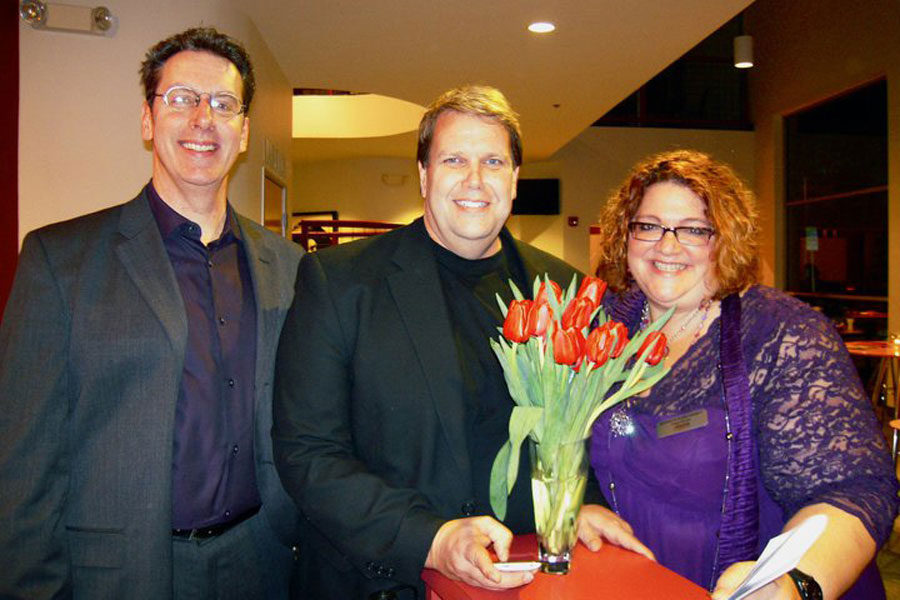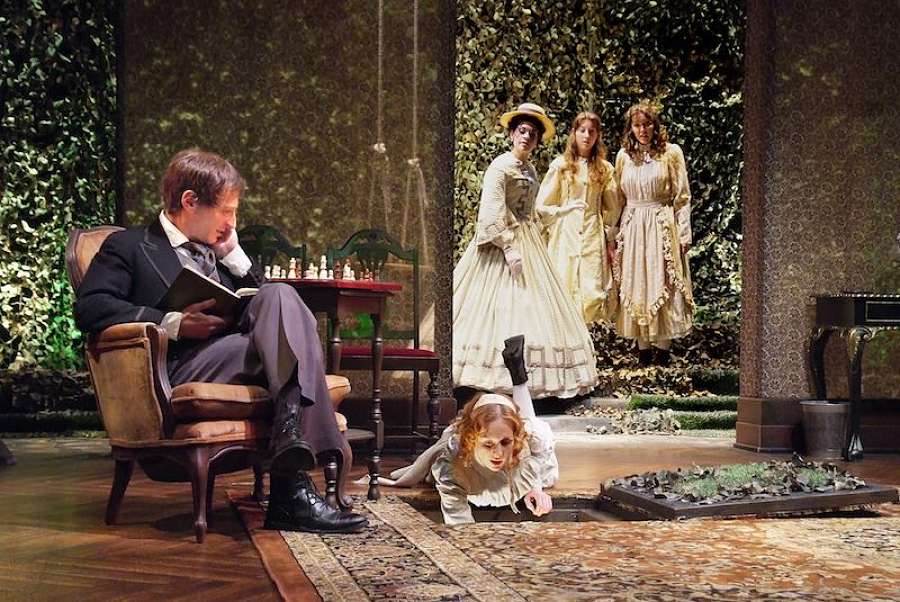When Oedipus entered Thebes on foot, presumably out of his mind from walking for days from Corinth, he staggered to a place referred to in Sophocles’ play as “where three roads meet.” There he confronted a carriage, a retinue, and a pompous man who ordered the pedestrian off the road. The delirious Oedipus refused. The passenger reportedly struck Oedipus on the head with a stick.
What happened next—you probably know the story—sealed Oedipus’s fate, to fulfill a destiny he was trying to flee. The hot-tempered young fellow was just struggling to figure out who he really was.
Pasadena’s Boston Court Performing Arts Center also finds itself at the intersection of three possible paths. And as it continues well into its second decade—the first Theatre @ Boston Court season was in 2003—this cultural outpost is trying to fathom its place in the precarious climate of Southern California’s shifting economic winds and competitive heat.
One road has a signpost that reads: Go it alone. Another says: Find reliable partners. On the third path is a looming figure in a carriage with a retinue. This figure has long permitted Boston Court to thrive in its custom-built 99-seat theatre; you might even think of this figure as a magnanimous parent. But now the figure carries a stick and appears angry. Emblazoned on its carriage: the logo for Actors’ Equity Association.
The theatre’s coming-of-age is evident in a story told by one of the theatre’s two co-artistic directors, Jessica Kubzansky. She says that years ago she wore a Boston Court T-shirt at the Humana Festival of New Plays in Louisville, Ky., “and people came up and said, ‘Oh my God, I love Boston.’” She adds, with a twinkle of pride, “I think more people are starting to know who we are.”
Like Oedipus, the Boston Court Performing Arts Center was born into a kind of royalty. It aimed to perform plays that were more experimental than traditional—or, if traditional, with experimental directorial approaches. But there was nothing scrappy about its origins; it did not move from a converted warehouse or garage near some railroad tracks. Rather, the state-of-the-art two-venue facility was custom-built by philanthropist Z. Clark Branson, partly to take advantage of Equity’s 99-seat plan, which had, when the theatre was being built, been in force for at least 15 years in Los Angeles County (where Pasadena is situated), and didn’t appear to be going anywhere, and partly—as Branson told LA Weekly in 2004—to fulfill his ambition of building a theatre from the ground up designed for the kind of theatre—intimate theatre—he had always found most challenging and exciting.
The 99-seat plan, whose fate is now in limbo (more on that in a moment), permitted union actors to volunteer their time in theatres of 99 seats or less, a cap calculated to avoid the exploitation of actors by producers. As the plan evolved, it also mandated that actors’ expense stipends rise from about $7 to $15 per performance. Boston Court currently reimburses its actors $25 per performance, along with rehearsal stipends that have climbed from $200, when the theatre launched its first season, to the current rate of $500. (Rehearsal stipends were never required at all under the 99-seat plan.)

The facility, about half a mile from central Pasadena, contains one 99-seat theatre and a smaller, flexible space for visual art, music, and dance. The thrust stage extends out to rows of seats curved in an arc, and bolted into a cement pad. The lighting grid, lighting board, and sound system are the envy of the region. Only larger theatres and local college and university campuses have equipment of such quality and value.
Branson subsidized the first few seasons at the performing arts center, based on a financial plan designed to decreasingly rely on his largesse while the theatre found alternate means of support. Much of the theatre’s viability derives from the combined frugality, fundraising, and strategic planning of facilities executive director Michael Seel and production manager Cheryl Rizzo.
But like the ornate estates of the landed gentry in 19th-century Russia, Boston Court is not, nor was it ever, as wealthy as it appears. The appearance of riches comes largely from Branson’s initial investment in top-tier lighting and sound equipment, combined with what’s now a tradition of attracting some of the best new plays in the country, from Mickey Birnbaum’s slaughterhouse epic Bleed Rail to Sheila Callaghan’s Everything You Touch to Luis Alfaro’s Oedipus El Rey and Mojada: A Medea in Los Angeles, performed at the Getty Villa but produced by Boston Court, as well as directors—not only Kubzansky and co-artistic director Michael Michetti but the likes of Cornerstone’s Michael John Garcés, who directed Boston Court’s recent production of Martin Zimmerman’s Seven Spots on the Sun. Not to mention, of course, the theatre’s capacity to attract the finest union actors in the region.
Whether or not every play the theatre presents is ready, or whether or not the directorial conceits imposed on its classics all pan out, the production value has a professional sheen comparable to L.A.’s Center Theatre Group and the best Off-Broadway houses.
As Kubzansky told the Weekly in 2004, “We want our actors to feel they have a home here.” The commitment shows: The dressing rooms and a green room are spotless and palatial, in contrast to the horse stalls found in so many intimate theatres across the county.
But these gleaming facades bear little relation to box-office revenue in a 99-seat theatre dedicated to presenting new works and unorthodox spins on classics. With the possible exception of runaway hits like Aaron Posner’s Stupid Fucking Bird, plays at Boston Court are generally not “hot ticket” items. Still, the perception of wealth has made the theatre Exhibit A for what Equity apparently thought was wrong with small L.A. theatre: an immaculate venue with acclaimed world-premiere plays that didn’t pay its actors minimum wage. (Executive director Seel’s annual salary, $78,000, includes overseeing music and visual arts programs in addition to the theatre.)
So last May, Equity’s national council overrode an April referendum in which L.A. membership had voted nearly two to one to support the continuing existence of the 99-seat plan. The union insists that the old 99-seat plan is history, and with a few carve-outs for membership companies and tiny workshop productions, plans to require all L.A. County theatres of all sizes to pay its members at least minimum wage for rehearsals and performances. (On Oct. 17, union plaintiffs ranging from Ed Asner to Amy Madigan and Ed Harris filed a lawsuit against the union for breach of good faith and fair representation in its dealing with L.A.’s membership.)
No representative of the theatre would discuss its dealings with Equity on the record, but they are said to have predated Equity’s proposed changes to the plan, the referendum, and the council’s decision. For now, though, Boston Court is making plans to implement AEA’s edict, scheduled to go into effect next April. Their 2016 season has already been sliced from four productions to three. Says Seel succinctly: “The real-life impacts are Boston Court hiring fewer actors, designers, directors, and stage managers.”
Seel adds that the new AEA agreement would represent “an approximate 40- to 45- percent increase to production budgets. Looking at one production (because they vary), under the new versus the old plan, the actor fee/costs increase by approximately 250 percent. Design fees are minimal increases based on what USA/Local 829 may be projecting.”

Grappling with AEA is the road yet to be taken. But recently the theatre has been exploring another avenue: a partnership with New York City’s Rattlestick Playwrights Theater. The pairing has proved so fruitful—a coproduction of Sheila Callaghan’s Everything You Touch first ran in Pasadena, then transferred to New York—that the idea of joining with other theatres across the country looks increasingly appealing (as larger regional theatres discovered some time ago). The benefit is obvious: An intimate local theatre gets its work seen by a considerably larger audience base.
Of course, the tough questions raised by such partnerships remain: Can theatres retain their artistic autonomy within such arrangements? Have institutional theatres transformed from laboratories into factories?
Autonomy wasn’t an issue with Everything You Touch. Boston Court’s founding producing director, Eileen T’Kaye, had worked at Rattlestick and made the intro. Early in rehearsal, Rattlestick artistic director David Van Asselt was so smitten with director Kubzansky’s approach that he offered to bring the production, as it was, to New York.
Explains Van Asselt, “When we started this thing with Sheila Callaghan, the idea was supposed to be separate productions—one by Boston Court, and one by Rattlestick. But Jessica’s production was too good not to take to New York.”
That was in February. Then, over the summer, Rattlestick mounted a production of Tom Jacobson’s The Twentieth-Century Way, directed by Michetti, and based on a 2010 Boston Court production. Around the same time, New York’s Flea Theater presented Boston Court’s production of Samuel Beckett’s Happy Days starring Brooke Adams and Tony Shalhoub. And the Boston Court/Rattlestick partnership recently branched out from the coasts with the Theatre LaB Houston’s November run of The Twentieth-Century Way.
These partnerships aren’t just labors of love, of course; they’re also born of fiscal reality. Explains Van Asselt, “Yes, it’s become increasingly difficult. The reality is, there’s a generation of funders who ‘got’ the theatre and understood what funding is about. We’ve lost that generation. The younger generation has a very different feel to it. The individual giving has changed” along with the decline of “subscriber-based theatres. We’re like that fancy restaurant where you have to have that fancy chef, but we don’t sell alcohol.”
Van Asselt and two partners, James Franco and Scott Haze, have started Rattlestick West in North Hollywood, with the aim of developing new works to bring to New York. Among the challenges of such partnerships, Van Assel adds, is finding common ground on which playwrights are worth producing—a sometimes subjective standard that, ironically, reduces the numbers of new plays staged in partnerships, as what might have been one theatre’s passion project morphs into more of a decision by committee.
While many of these deals came about by chance, one key for future stability is to take serendipity out of the equation. Explains co-artistic director Michetti, “I think we’re about to enter another strategic planning sequence, and we’ll talk about how to make it happen by design rather than accidentally.” The coproductions are good for both the artists and the theatre, and these goals are mutually beneficial, Michetti says: “Artists want to have their work seen elsewhere, beyond our theatre,” while “we continue to build our national reputation by working in other places, which will give us greater resources for the artists and for the plays. That’s our hope anyway. No, that’s our plan.”
Steven Leigh Morris was theatre critic for LA Weekly and editor of StageRaw. He was recently named executive director of LA STAGE Alliance.


